Click on images to enlarge
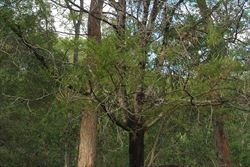
habit (Photo: Sheldon Navie)
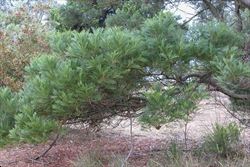
habit (Photo: Greg Jordan)

bark on main trunk (Photo: Sheldon Navie)
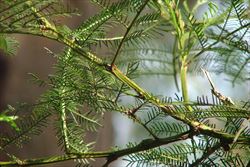
younger branches and leaves (Photo: Sheldon Navie)
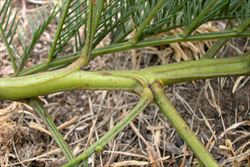
the distinctive flanges on the branches, which emanate from the leaf bases (Photo: Greg Jordan)
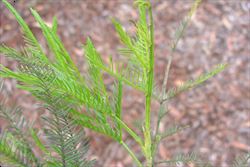
light green or yellowish-green foliage tips (Photo: Sheldon Navie)
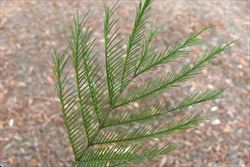
twice-compound leaf with several to numerous pairs of branchlets (Photo: Sheldon Navie)
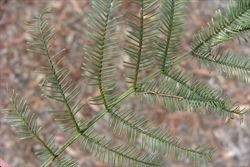
close-up of leaf showing the small raised glands where the leaf branchlets meet the central stalk (Photo: Sheldon Navie)
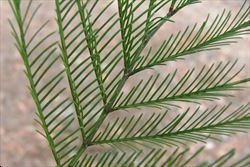
close-up showing the very narrow and widely-spaced leaflets (Photo: Sheldon Navie)
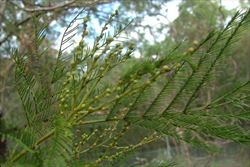
young flower clusters (Photo: Sheldon Navie)
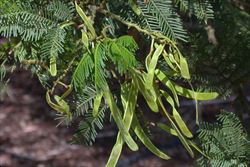
immature fruit (Photo: Rob and Fiona Richardson)
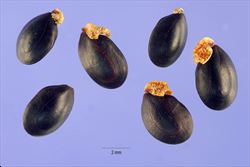
close-up of seeds with small fleshy arils (Photo: Steve Hurst at USDA PLANTS Database)
Scientific Name
Acacia decurrens Willd.
Synonyms
Acacia angulata Desv.Acacia decurrens Willd. forma decurrensAcacia decurrens Willd. forma normalis Benth.Acacia decurrens Willd. var. angulata (Desv.) Benth.Acacia decurrens Willd. var. decurrensAcacia decurrens Willd. var. normalis Benth.Acacia decurrens Willd. var. normalis E. MiegeAcacia decurrens Willd. var. normalis MaidenAcacia mollissima Willd. var. angulata (Desv.) Walp.Acacia normalis E. MiegeMimosa angulata (Desv.) Poir.Mimosa decurrens Wendl.Mimosa decurrens DonnRacosperma decurrens (Willd.) Pedley
Family
Fabaceae: sub-family Mimosoideae (New South Wales)Leguminosae (South Australia)Mimosaceae (Queensland, the ACT, Victoria, Tasmania, Western Australia and the Northern Territory)
Common Names
bark wattle, early black wattle, golden wattle, green wattle, Queen wattle, Sydney green wattle, tan wattle
Origin
Sydney green wattle (Acacia decurrens) is native to some parts of central and southern New South Wales (i.e. it is endemic to NSW). It is mainly found in the coastal and tableland districts from the Hunter Valley south to the Ulladulla district, and it is particularly common in the Sydney region. However, the natural distribution of this species is somewhat confused by naturalisation, caused by widespread plantings as an ornamental and in forestry plantations.
Cultivation
In the past, plantations of Sydney green wattle (Acacia decurrens) were established along the eastern coast of Australia, to service the tanning industry. These plantations no longer exist, though their remnants may persist in some areas. However, this species is still widely cultivated as a garden ornamental in Australia, and it may often be seen growing in inhabited areas.
Naturalised Distribution
Naturalised to some extent in south-western Western Australia, south-eastern South Australia, Tasmania, south-eastern Queensland and the ACT. In Victoria it is widely naturalised in the western and central parts of the state, and is particularly common north-east of Melbourne. It is also naturalised beyond its native range in some parts of New South Wales (i.e. in the North Coast, Central Western Slopes and South Coast regions).
This species was introduced to southern Africa many years ago, where it was used in the tanning industry, and it is now widely naturalised there. It is also becoming naturalised in California, in the south-western parts of the USA.
Habitat
This species grows naturally in open woodlands, dry forests and heathlands in New South Wales, where it often inhabits hillsides, riverbanks and gullies.
In areas where it has become naturalised, Sydney green wattle (Acacia decurrens) is generally found on roadsides, along creeklines and in waste areas. It also grows in disturbed sites in nearby bushland and open woodlands
Habit
A tall shrub or tree to usually growing 2-10 m tall, but occasionally reaching up to 15 m in height.
Distinguishing Features
- a large shrub or tree with twice-compound dark green leaves.
- its young branches are generally hairless with conspicuous wings or ridges that emanate from the leaf bases.
- its main leaf stalk is hairless with a small raised glands at the junction of each pair of leaf branchlets.
- its yellow or golden-yellow flowers are borne in small globular clusters that are arranged into larger elongated compound clusters.
- its fruit is an elongated and somewhat flattened pod (20-105 mm long).
Seedling
Seedlings have two undivided seed leaves (i.e. cotyledons). The first true leaves are usually twice-compound (i.e. bipinnate), but only with one or a few pairs of branchlets (i.e. pinnae).
Stems and Leaves
The bark of older stems is fissured and brown, dark grey or black in colour. Younger stems have smooth bark and the branches have conspicuous wings or ridges (0.5-2 mm high) that emanate from the leaf bases (i.e. they are decurrent). These branches are hairless (i.e. glabrous), or sparsely covered in very small hairs (i.e. puberulent), and the young foliage-tips are yellowish-green or yellow in colour.
The leaves are twice-compound (i.e. bipinnate) and dark green on both sides. These leaves (5-15 cm long) are alternately arranged along the stems and are stalked (i.e. petiolate). The leaf stalk (7-35 mm long) is ridged, generally hairless (i.e. glabrous), and usually bears a prominent raised structure (i.e. gland). This gland is almost round in shape, usually found towards the base of the leaf stalk, and is always more than 7 mm below the lowest pair of leaf branchlets (i.e. pinnae). The extension of the leaf stalk (i.e. rachis) bears several to numerous (3-15) pairs of leaf branchlets (i.e. pinnae). It is 2-12 cm long, generally hairless (i.e. glabrous), and bears a small raised structure (i.e. gland) at the junction of the each of the pairs of leaf branchlets (i.e. pinnae). The leaf branchlets (25-90 mm long) have numerous (15-45) pairs of widely-spaced leaflets (i.e. pinnules). These leaflets (5-15 mm long and only 0.3-1 mm wide) are linear in shape, mostly hairless (i.e. glabrous), and have rounded or somewhat pointed tips (i.e. obtuse to sub-acute apices).
Flowers and Fruit
The small yellow or golden-yellow flowers are very fluffy in appearance and are densely arranged into small globular clusters (4-7 mm across). These flowers have five relatively inconspicuous petals and sepals and numerous conspicuous stamens. The globular flower clusters each contain numerous (20-32) flowers and are are borne on short stalks (i.e. peduncles) 2-7 mm long. They are arranged along a small branch emanating from the forks (i.e. axils) of the leaves, or occasionally borne at the tips of the stems. These branches may or may not be further branched (i.e. they form inflorescences resembling racemes or panicles). Flowering generally occurs during late winter and early spring (i.e. from July to September).
The fruit is an elongated and somewhat flattened pod (20-105 mm long and 4-8.5 mm wide). These pods are usually slightly constricted between some or all of the seeds and turn brown or dark brown in colour as they mature. They are hairless (i.e. glabrous), smooth in texture, and are normally present during late spring and summer (i.e. from November to January). Each pod contains several seeds (about 3-4 mm long) which have a small fleshy structure (i.e. aril) attached to them.
Reproduction and Dispersal
Reproduction in this species is entirely by seed. These seeds may be dispersed by ants, wind and water. They may also be spread in dumped garden waste and contaminated soil.
Environmental Impact
Sydney green wattle (Acacia decurrens) has escaped from old forestry plantations and garden plantings in many parts of Australia, particularly in cooler temperate regions and highland areas. In Victoria it is quite widespread and regarded as a significant environmental weed, while in South Australia it is of most concern in the Adelaide Hills area. In south-western Western Australia it is mainly found on roadsides, along creeklines and in waste areas between Perth and Albany. However, it is also beginning to invade disturbed woodlands in this part of the country, particularly along creeks. In south-eastern Queensland it is regarded as an emerging native weed, but is mainly restricted to the cooler highland areas near Stanthorpe and Toowoomba.
In South Africa, Sydney green wattle (Acacia decurrens) is a very serious problem and invades grasslands, roadsides and watercourses. Because of its ability to transform South African grasslands into exotic woodlands, it is one of several Australian wattles that are known locally as the "green cancer".
Legislation
This species is not declared or considered noxious by any state or territory government in Australia.
Management
For information on the management of this species see the following resources:
- the Woody Weeds Information Pamphlet on the Environmental Weeds Action Network (EWAN) website at http://members.iinet.net.au/~ewan/.
- Moore and Wheeler (2002), Southern Weeds and their Control, pp. 134-140.
Similar Species
Sydney green wattle (Acacia decurrens) may be confused with several other species of native wattles (Acacia spp.) including silver wattle (Acacia dealbata subsp. dealbata), black wattle (Acacia mearnsii), green wattle (Acacia irrorata) and Parramatta green wattle (Acacia parramattensis). These species can be distinguished by the following differences:
- Sydney green wattle (Acacia decurrens) has young branches with conspicuous flanges and foliage tips that are mostly hairless and yellowish in colour (i.e. not pruinose). Its dark green leaves have several to numerous (3-13) pairs of hairless branchlets (i.e. glabrous pinnae). These leaves are shortly-stalked (i.e. petiolate) and there is usually a small raised gland near the top of this leaf stalk. There are also similar glands at the junction of the each of the pairs of branchlets (i.e. jugary glands). The widely-spaced leaflets are quite large (5-15 mm long) and very narrow. Its flowers are yellow or golden-yellow in colour.
- silver wattle (Acacia dealbata subsp. dealbata) has young branches and foliage tips that are finely hairy and whitish-green or whitish-yellow in colour (i.e. pruinose). Its silvery-grey leaves have numerous (10-30) pairs of hairy branchlets (i.e. pubescent pinnae). These leaves are shortly stalked (i.e. petiolate) and there is usually a small raised gland near the top of this leaf stalk. There are also similar glands at the junction of the each of the pairs of branchlets (i.e. jugary glands). The leaflets are relatively small (1.5-6 mm long) and usually quite elongated in shape. Its flowers are yellow or golden-yellow and in colour.
- black wattle (Acacia mearnsii) has young branches and foliage tips that are finely hairy and yellow or greenish-yellow in colour (i.e. not pruinose). Its dark green leaves have numerous (7-31) pairs of hairy branchlets (i.e. pubescent pinnae). These leaves are shortly stalked (i.e. petiolate) and there is usually a small raised gland near the top of this leaf stalk. There are also similar glands at the junction of the each of the pairs of branchlets (i.e. jugary glands), and also between some or all pairs of branchlets (i.e. interjugary glands). The leaflets are quite small (1-3.5 mm long) and usually not particularly elongated in shape. Its flowers are pale yellow or cream-coloured.
- green wattle (Acacia irrorata) has young branches and foliage tips that are finely hairy and yellow, greenish yellow or orange in colour (i.e. not pruinose). Its dark green leaves have numerous (5-26) pairs of hairy branchlets (i.e. pubescent pinnae). These leaves are shortly stalked (i.e. petiolate) and there is no gland near the top of this leaf stalk. However, there are small glands at the junction of the some of the pairs of branchlets (i.e. jugary glands). The leaflets are relatively small (2-5 mm long) and usually quite elongated in shape. Its flowers are pale yellow or cream-coloured.
- Parramatta green wattle (Acacia parramattensis) has young branches and foliage tips that are somewhat hairy and yellowish in colour (i.e. not pruinose). Its dark green leaves have several to numerous (3-16) pairs of hairless or slightly hairy branchlets (i.e. glabrous or puberulent pinnae). These leaves are shortly stalked (i.e. petiolate) and there is usually a small raised gland near the top of this leaf stalk. There are also similar glands at the junction of the each of the pairs of branchlets (i.e. jugary glands), and also sometimes between some or all pairs of branchlets (i.e. interjugary glands). The closely-spaced leaflets are relatively small (2-9 mm long) and very narrow. Its flowers are pale yellow to bright yellow in colour.
Hybrids of Sydney green wattle (Acacia decurrens) with Cootamundra wattle (Acacia baileyana) and black wattle (Acacia mearnsii) are also known to occur. In both cases, these hybrids are intermediate between the two species involved.
Note: This page only covers those species that have been reported to be commonly confused with silver Sydney green wattle (Acacia decurrens). For a more in-depth key to all of the wattle (Acacia spp.) present in Australia, see the Wattle: Acacias of Australia CD-ROM or Flora of Australia, Volumes 11A and 11B.

